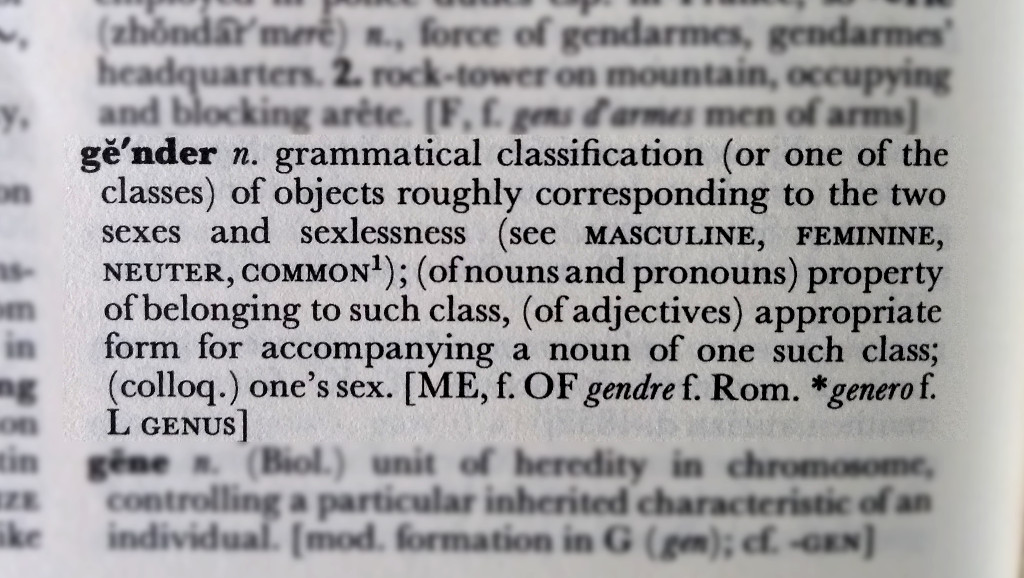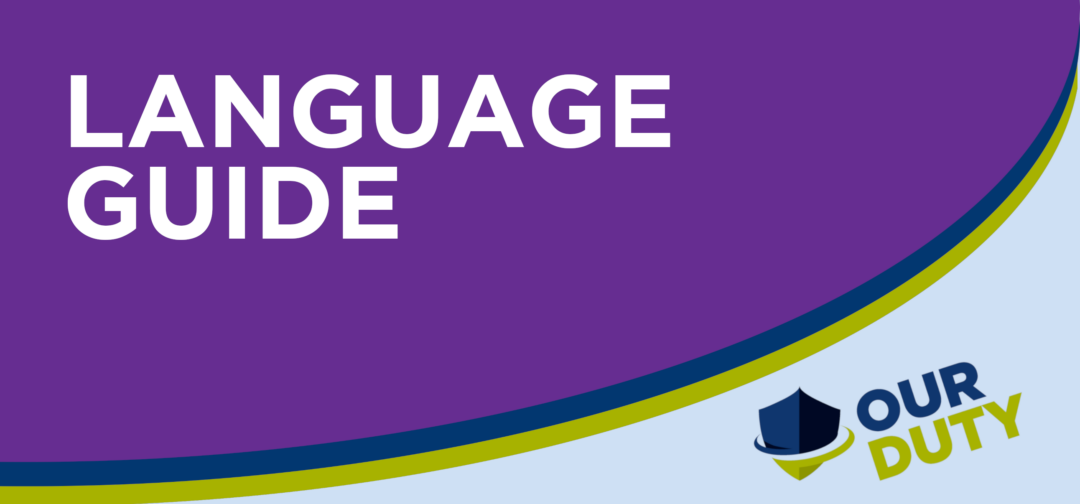Whether writing or talking about issues relating to gender, one must use accurate, objective, unbiased language.
Gender terminology is vast and constantly evolving; a style guide can’t cover everything. Where there is doubt then use your judgment. As a rule, being honest and factual is preferable to being considerate of feelings. This is when reporting differs from interpersonal relations which might benefit from courtesy in certain situations.
Avoid false balance — giving a platform to unqualified claims or sources in the guise of balancing a story by including all views. For instance, don’t quote people asserting the existence of regulations, or social effects, unless those assertions are verifiable with evidence. If you do need to use the quotes, fact-check them within the story. Ensure that organisations offering data or other factual information in a story are using sound methodology grounded in valid science.
Gender is primarily a linguistic term, historically it has been used as a synonym for sex, however with the emergence of gender identity ideology, it is now seen as a separate putative characteristic most often aligned with sex-based stereotypes. In this context it is a social construct suggested to be equivalent to, but somehow different from, sex. Thus, it is possible for a person to be of one sex yet claim to be of a gender different to that sex. There is no objective test for gender, nor is there any evidence that people have a gender identity. Consequently, the word gender is best avoided completely outside the field of linguistics, unless it is necessary to discuss the phenomenon of gender identity ideology.

Sex refers to the physical characteristics a person has developed to produce either the small gamete (sperm), or the large gamete (ova/eggs). Not all men produce sperm, but everyone who produces sperm is a man, likewise, not all women produce ova, but everyone who produces ova is a woman. Sex is defined by the reproductive equipment a person develops, but it is determined by their genes, and in particular the presence of the SRY gene usually found on the Y chromosome. Thus, men almost always have XY chromosomes, and women XX. Exceptions to this norm are very, very rare, and these are called variations of sex development or VSDs, or differences of sex development or DSDs (never ‘intersex’ which is derogatory and offensive). People with VSDs are all either male or female. Sex is, therefore, binary, it is also immutable (it cannot be changed).
Since everyone will fall under one of two categories for sex, and gender is vague, often unknowable, frequently transient, contentious, and politically charged, it is usually best to refer to someone by their sex where this is necessary. For example, when choosing which pronouns to use.
A person of one sex who claims a gender identity incongruent with that sex is said to be transgender. It is primarily a social identity; however, the social norms of the transgender community pressurise members to undertake medical interventions to better resemble the stereotypical appearance of their desired identity.
Terminology and red flags
At its most basic, transgender is an adjective describing a person who does not wish to be identified by their sex. For example, a person may be born a boy but may grow up feeling uncomfortable. It should be noted that such a boy might claim to feel like a girl, but since it is impossible to know what that feels like (even for a girl) it is likely a shorthand for preferring clothing or hairstyles typically associated with girls. When this happens with prepubescent boys, about 90% will grow out of such feelings naturally, with the great majority being homosexual.
Some people consider themselves ‘nonbinary‘. Often this is because they are uncomfortable with their sex but do not wish to claim to be the opposite sex. Sometimes this is part of the pathway towards claiming to be the opposite sex when a young person is being groomed into transgenderism, i.e. it is a stepping-stone aimed at overcoming parental objections by taking smaller steps. This pathway is often referred to as ‘the script‘.
Use the term sex instead of, sex assigned at birth, biological sex, birth gender, was identified at birth as and the like.
Use boy, girl, man or woman. Sex is immutable, so phrases like born a girl are pointless – a girl grows into a woman. Hence, also never use and is now a man.
The word identify is frequently used to describe how someone views themselves and can be useful when writing about issues of identity. Never say that a man is a woman, identifies as a woman can help point to a transgender identity.
Avoid terms like biological sex, along with biological male and biological female, these terms imply there can be another kind of sex (or kind of male or female), there cannot. Just use sex, along with male and female because sex is inherently biological.
Where possible, avoid the terms transgender woman and transgender man because it is impossible to determine the sex of the person to whom you refer.
The terms, transwoman and transman (never with a space) are best avoided.
If necessary to directly quote someone using the term, add that context. For example: “She is a transwoman, pure and simple,” Smith said, using a term that falsely implies he was something other than a man.
Exercise caution when using the terms groom or groomer, generally activists and captured institutions indoctrinate. Individuals groom. (If child abuse actually is what is being alleged or proven, include those details.)
Do not use the term transgendered or use transgender/s as a noun.
The term transgenderism, which frames transgender identity as an ideology, or as a condition, can be useful. Transgender ideation is preferred. For example, “Her transgenderism started in 2016 but now she has put it all behind her.”
Opposite-sex imitation and other interventions
As with all ideations, the recommended treatment for transgender ideation is talking therapies. These do not necessarily require the employment of a therapist, parents are often best placed to help especially when supported appropriately.
Medical treatment for adolescents with transgender ideation is advocated for by powerful vested interests and politicians. The move to re-introduce evidence into such medicine is being resisted wherever so-called gender affirming care (a term to be avoided) has become established. Some legislatures, particularly in the United States, but also Finland and Sweden, have applied restrictions while others are pressing ahead with embedding unevidenced practice. Major medical associations have largely succumbed to the promotion of medical interventions as a valid treatment.
Proponents of youth transgender medical treatment say there’s proof of purported benefits, cite widely discredited research, say children can make life-altering decisions, and that regret is rare.
Treatment typically begins with an evaluation for gender dysphoria, supposedly a diagnosis of the distress caused when a self-perception of gender doesn’t match a person’s sex; in fact it is a list of feelings that can be easily claimed. There is no scientific test. If children meet guidelines (originating from activist groups) and are showing signs of puberty, they can be prescribed puberty blockers — medication that halts puberty and can lead to failure to develop – particularly in bone density, brain formation, and genital maturity. Claims such an intervention is reversible are patently false and misleading.
Studies show that 98% of children receiving puberty blockers go on to take cross-sex hormones. These are also prescribed to those seeking to imitate the opposite sex if they have already completed puberty. Exogenous, opposite-sex hormones – i.e. testosterone given to girls, or estrogen given to boys – will lead to changes in appearance as well as detrimental effects on the reproductive and other systems.
Opposite-sex imitation can proceed further with surgery. Avoid the terms top-surgery or bottom-surgery, these are euphemisms designed to disguise reality. Radical bilateral mastectomies are given to girls to remove their breasts. A phalloplasty is the construction of a fake penis using tissue harvested from elsewhere, typically a forearm. Vaginoplasty is the construction of a fake vagina which requires the removal of the testes and destruction of the penis. It is unlikely that truly informed consent can be given for these procedures.
The word mutilation should be avoided; while it accurately describes the surgeries performed, the word is upsetting to survivors.
Research suggests that youth and adults with transgender ideation are prone to stress, depression and suicidal thoughts, and the evidence indicates that treatment with hormones or surgery worsens those issues.
Allowing children to express themselves in ways that do not conform to the stereotypes associated with their sex is beneficial, suggesting such behaviour means that they are transgender (or even the opposite sex) is harmful. Avoid phrasing that implies that someone actually is transgender. This is because there is controversy around whether such an identity is merely social, medical, or innate. Better to say they have transgender ideation, or think of themselves as transgender. Accuracy is particularly important when there is a risk of giving validity to a point of view that might subsequently be use in appeals to authority by young people with transgender ideation.
The term sex change is considered to be outdated, however, when it is clear the audience understands the nature of medical interventions for transgender ideation, it can be a useful literary device.

